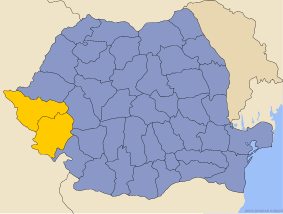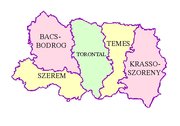Banat
|
|
Banat (Romanian, Serbian, and German: Banat; Hungarian: Bánát or Bánság; Slovak: Banát) is a region in Southeastern Europe divided among three countries: the eastern part belongs to Romania (the counties of Timiş and Caraş-Severin), the western part to Serbia-Montenegro (the Serbian Banat, mostly included in the Vojvodina, except for a small part included in Central Serbia), and a small northern part to Hungary (Csongrád county). It is part of the Pannonian plain bordered by the Danube river in the south, the Tisza (Theiss, Tissa, Tisa) river in the west, the Mureş in the north and the Southern Carpathians in the east. Its historical capital was Timişoara (Hungarian: Temesvár, Serbian: Temivar), in the County of Timiş, Romania.
The term Banat designated a frontier province governed by a ban.
There were several banats in the Kingdom of Hungary, such as the banats of Dalmatia, of Slavonia, of Bosnia and of Croatia; these disappeared during the course of the Turkish Wars. But when the word is used without any other qualification, it indicates the Timişoara Banat, which strangely acquired this title after the Treaty of Passarowitz (1718), though it was never governed by a ban.
| Contents |
Geography
Romanian Banat

On 29 July 1929, the existing counties formed the Timiş Province: Timiş-Torontal, Caraş- Severin, Arad, and Hunedoara.
On 6 September 1950, instead of the province, was enforced the Timişoara Region (formed by today's counties Timiş and Caraş-Severin).
In 1956, the southern half of the existing Arad Region was incorporated to Timişoara Region. In December 1960, Timişoara Region was named Banat Region.
Starting 17 February 1968, a new territorial division was made in Romania and today's Timiş, Caraş-Severin and Arad counties were formed.
Recently, Romania has been split into 8 financial regions, which act as a sort of territorial autonomy divisions. The eight regions are: North-East, South-East, South, South-West, West, North-West, Center, and Bucharest. The West region is composed of counties: Arad, Timiş, Hunedoara, and Caraş-Severin, thus it had almost same borders as the Timiş Province from 1929. The West financial region is also a part of the Danube-Kris-Mures-Tisa euroregion.
The Romanian Banat is mountainous in the south and southeast, while in the north, west and south-west it is flat and in some places marshy. The climate, except in the marshy parts, is generally healthy. Wheat, barley, oats, rye, maize, flax, hemp and tobacco are grown in large quantities, and the products of the vineyards are of a good quality. Game is plentiful and the rivers swarm with fish. The mineral wealth is great, including copper, tin, lead, zinc, iron and especially coal. Amongst its numerous mineral springs, the most important are those of Mehadia, with sulphurous waters, which were already known in the Roman period as the Termae Herculis (Băile Herculane). Note that part of the "Banat Region" of Romania includes some areas that are mountainous and were not part of the historical Banat or of the Pannonian plain.
Serbian Banat
The Serbian Banat (Western Banat) was part of the Torontál and Temes counties of Austria-Hungary after 1860. The center of Torontál county was Veliki Bečkerek (Hungarian: Nagybecskerek, Romanian: Becicherecul Mare), the current Zrenjanin.
The region was a County of the Kingdom of Serbs, Croats and Slovenes between 1918 and 1922, and in 1929 it was incorporated into the Dunavska banovina (Danubian Banat), a province of the Kingdom of Yugoslavia.
Between 1941 and 1944 the Serbian Banat was occupied by the Axis powers. Formally it was part of Serbia, but it actually was a separate autonomous region ruled by a German minority. Since 1945 the Serbian Banat (together with Backa and Srem), is part of the Autonomous Province of Vojvodina.
In Serbia, the banat is mostly plains. Wheat, barley, oats, rye, maize, hemp and sunflower are grown, and mineral wealth consists of oil and natural gas. A popular tourist destination in Banat is Deliblatska Pescara.
M_vojvodina02b.jpg
The districts of Serbia in Banat are:
See also Geographical regions in Serbia and Montenegro
Hungarian Banat
Consisted of a small northern part of the region incorporated into Csongrád County.
History
Before the Roman Empire under Trajan conquered the region of the Banat in 106 AD, the land was inhabited by Dacians. Roman rule was eventually overextended, however, and Emperor Aurelian (270-275) withdrew Roman forces to south of the Danube, leaving behind a Romanized population.
Salan_glad01.gif
Ahtum_sermon01.gif
During the early medieval migrations, Slavs settled today's Banat in the 6th century. In the 9th century the territory of present-day Banat was part of the First Bulgarian Empire. The Hungarian historical chronicle Gesta Hungarorum speaks of a duke called Glad, a ruler in the territory of Banat who came from Vidin. His descendant was Ahtum, the last ruler, who was opposed to the establishment of the Hungarian Kingdom. Ahtum was an Orthodox Christian.
The region was conquered by the Kingdom of Hungary in the 11th century and was divided into the counties Torontál, Temes, Krassó and Szörény.
The Banat was conquered by the Turkish Ottoman Empire in 1552, and became a Turkish eyalet (province) named the Eyalet of Temesvar. In 1594 Serbs in Banat started a large uprising opposing the Turkish rule.
Banat.gif
In the 17th century, parts of the Banat were captured by the Habsburg Monarchy of Austria. In 1716, Prince Eugene of Savoy conquered the last parts of Banat from the Ottomans. It received the title of Banat after the Treaty of Passarowitz (1718), and remained a separate province of Austria under military administration until 1751, when Maria Theresa introduced a civil administration. The Banat province of Austria was abolished in 1778. The southern part of the Banat remained part of the Military Frontier (Banat Krajina) until it was abolished in 1871.
During the Turkish rule the district was nearly depopulated after years of warfare, and was allowed to lie almost desolate in marsh, heath, and forest. Count Claudius Mercy (1666-1734), who was appointed governor of Timiş in 1720, took numerous measures for the regeneration of the Banat. The marshes near the Danube and Tisza rivers were cleared, roads and canals were built at great expense of labour, German artisans and other settlers were attracted to colonize the district, and agriculture and trade encouraged. Maria Theresa also took a great interest in the Banat; she colonized the land belonging to the crown with German peasants, founded many villages, encouraged the exploitation of the mineral wealth of the country, and generally developed the measures introduced by Mercy. Germans arrived from Swabia, Alsace and Bavaria, as well as people from Austria. Many settlements in the eastern Banat were mostly German-inhabited. The Germans in the Banat region became known as the Danube Swabians, or Donauschwaben.
In 1779 the Banat was incorporated into Habsburg Hungary, and the three counties Torontál, Temes and Krassó were recreated. After the Revolution of 1848-1849, the Banat (together with Srem and Backa) was separated from Hungary and made into a separate Austrian crownland known as the Vojvodina of Serbia and Tamiš Banat (German: Woiwodschaft Serbien und Temescher Banat), but in 1860 this province was abolished and incorporated again into Hungary.
After 1871, the former Military Frontier was reincorporated into the Banat. Krassó and Szörény were united into Krassó-Szörény in 1881.
In 1918, Banat Republic was proclaimed in Timisoara, and government of Hungary has recognized its independence, but it was short-lived. After several days, Serbian troops entered Banat, and that was the end of the Banat Republic.
In 1918 (confirmed by the Treaty of Trianon 1920), most of the Banat became part of Romania: (Krassó-Szörény completely, 2/3 of Temes, and a small part of Torontál). The southwestern part (most of Torontál, 1/3 of Temes) became part of the newly formed Kingdom of Serbs, Croats and Slovenes (which became Yugoslavia). A small area near Szeged became part of newly independent Hungary. The territory of Banat is presently in the Romanian counties Timiş, Arad and Caraş-Severin, the Serbian autonomous province of Vojvodina and Belgrade City District, and the Hungarian county Csongrád.
Symbols
The traditional heraldic symbol of the Banat is a lion, which is nowadays present in both, the Coat of Arms of Romania and the Coat of Arms of Vojvodina.
| Romanian historical regions: |
| Dobrogea : Cadrilater
Moldavia : Bessarabia | Bugeac | Bukovina Transylvania : Banat | Crişana | Maramureş |

